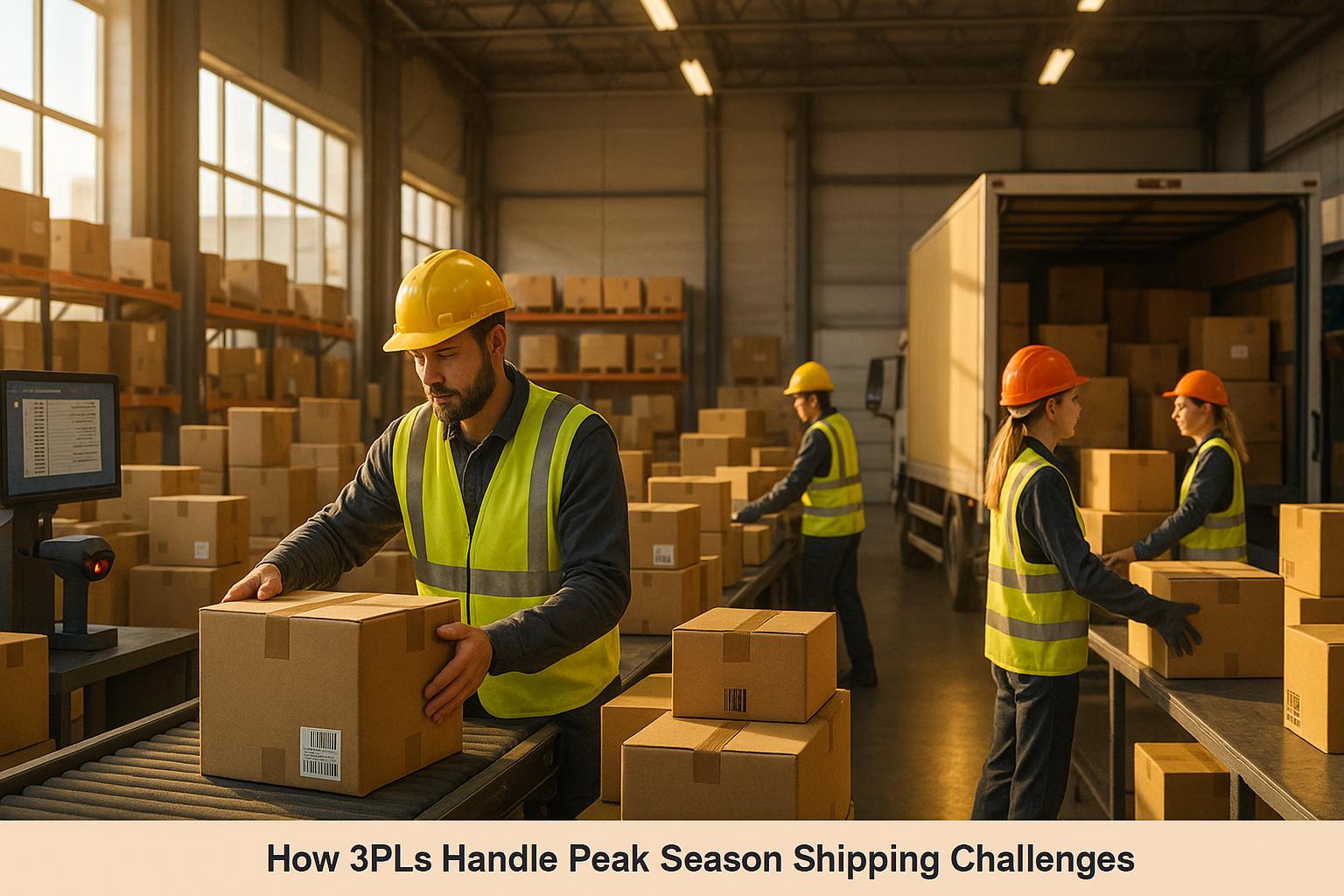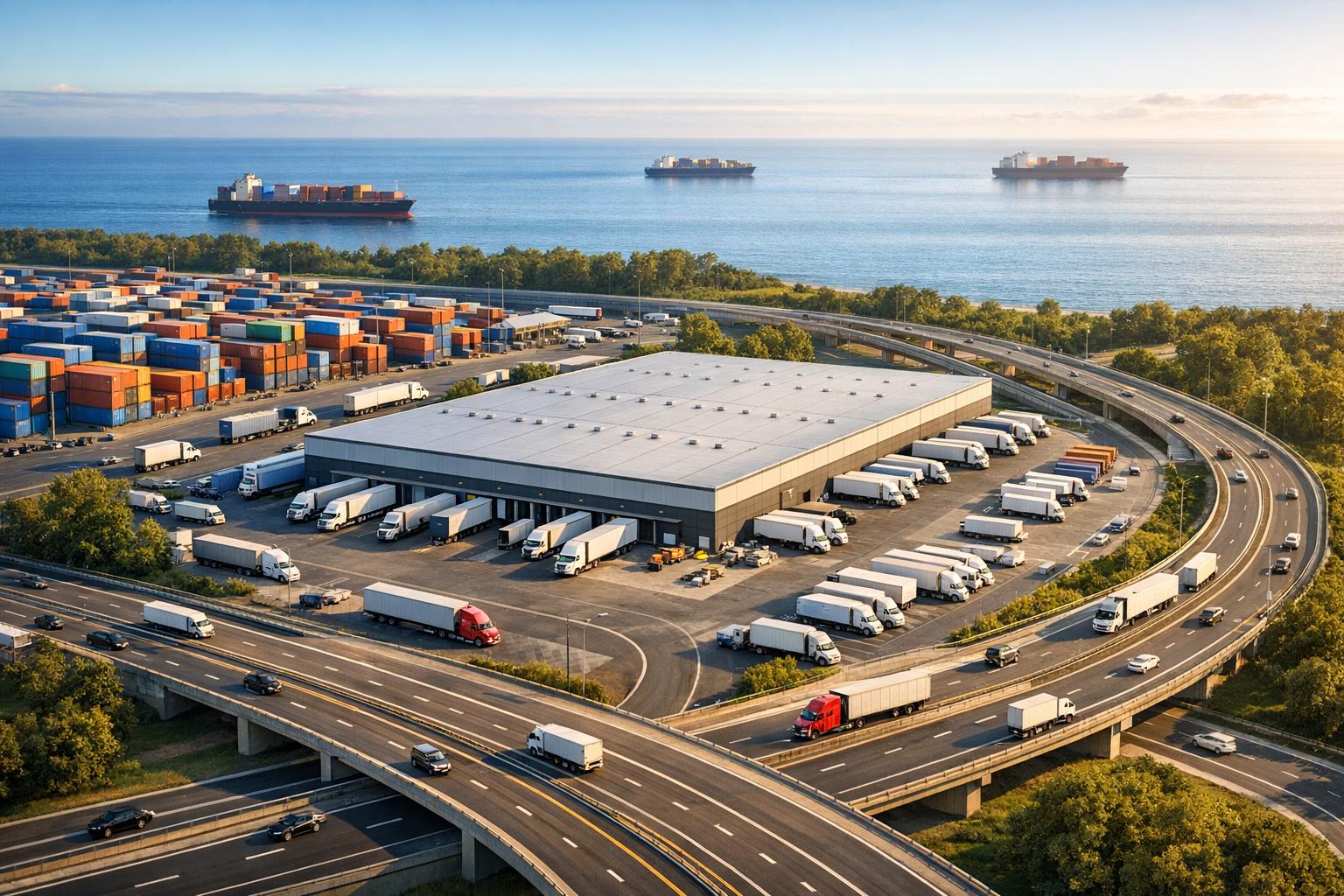How 3PLs Handle Peak Season Shipping Challenges

Peak shipping season - August through December - brings intense demand spikes due to back-to-school shopping, holiday sales, and e-commerce growth. Businesses face higher freight rates, capacity shortages, warehouse overcrowding, labor gaps, and weather disruptions, all of which can delay shipments and harm customer satisfaction.
Third-party logistics (3PL) providers offer solutions like:
- Access to extensive carrier networks to secure capacity.
- Tools for demand forecasting, route optimization, and shipment tracking.
- Multi-modal transportation options to manage costs and delays.
- Flexible staffing and warehouse adjustments to handle volume surges.
- Strong carrier partnerships and shipment consolidation to reduce costs.
Key stats:
- Freight rates can jump 30% during peak season.
- 25% of contracted loads are rejected by carriers.
- 40% of consumers abandon brands after poor delivery experiences.
Peak Season Shipping Challenges Explained
What Peak Season Means and Its Effects
From August to October, transportation networks across the United States face a dramatic shift. This period, known as peak season, sees freight demand skyrocket due to back-to-school shopping and preparations for the holiday surge in consumer spending. It’s not just about moving more packages - this time of year transforms how transportation systems function.
For instance, container imports increased by 46% year-over-year in March, while spot ocean rates from Asia to the U.S. West Coast surged by 228%. Adding to the pressure, e-commerce growth has fueled even greater demand, with consumers often delaying purchases in anticipation of discounts.
Main Transportation Problems
The demand spike during peak season creates a host of logistical challenges that can strain businesses to their limits. One of the biggest issues is capacity. Carriers reject about 25% of contracted loads during this period, leaving companies scrambling for alternatives. Pricing is another concern - ocean freight rates can climb by as much as 30%, and airfreight rates often increase even more dramatically.
Warehouse overcrowding and labor shortages exacerbate these issues. In fact, 61% of supply chain and logistics companies reported disruptions due to understaffing, and 58% noted that these challenges negatively impacted customer service. Weather-related issues add another layer of unpredictability. For example, during the 2023 holiday season, financial struggles forced several trucking companies to shut down, leaving retailers desperate to find transportation solutions.
Another major hurdle is limited visibility. During busy periods, businesses often struggle to track shipments or provide accurate delivery windows. This lack of transparency leads to inefficiencies and frustrated customers. Navigating these obstacles requires expertise and resources that many companies simply don’t have - but third-party logistics providers (3PLs) can bridge the gap.
How 3PLs Help Solve These Problems
Third-party logistics providers excel at turning peak season chaos into streamlined operations. Their vast carrier networks give businesses access to capacity that would otherwise be out of reach. By leveraging advanced forecasting tools, 3PLs can predict demand surges, identify potential bottlenecks, and create contingency plans well ahead of time.
Flexibility is another key advantage. 3PLs offer multi-modal transportation options, allowing businesses to switch between shipping methods when traditional routes become too expensive or congested. A great example of this is Nike’s decision to shift to air freight in 2021 to avoid delays caused by ocean freight disruptions.
Technology also plays a significant role. Many 3PLs use transportation management systems to provide real-time tracking, automated updates, and predictive analytics. This level of visibility improves communication and reduces uncertainties, keeping operations on track.
Finally, 3PLs are experts in risk management. They implement advanced security measures to combat cargo theft, which saw a significant rise in 2022 at major transshipment hubs in the U.S. and Europe. Their deep understanding of carrier behavior and capacity trends during peak season gives businesses a critical edge when conventional strategies fall short.
Planning Capacity and Forecasting for Peak Seasons
Using Data to Predict Demand
To gear up for peak seasons, 3PLs rely on months of preparation rooted in data analysis. Historical sales data forms the backbone of this process, offering insights into patterns that reveal when order volumes are likely to surge. When businesses share their past sales figures with 3PL providers, it enables precise adjustments to inventory levels and transportation needs based on anticipated demand.
Take, for instance, an online retailer that saw a 300% jump in orders during a recent holiday season. Similarly, Amazon Prime Day 2024 raked in over $14.2 billion in global sales. These aren’t random spikes - they’re predictable events that experienced logistics providers can plan for well in advance.
AI-driven predictive tools further refine this process by forecasting demand surges and optimizing supply chain decisions. These systems help determine how to distribute inventory across multiple locations and calculate staffing requirements for each facility.
Collaboration plays a critical role here. By aligning forecasts and supply chain strategies early on, 3PLs and their clients can minimize disruptions and keep operations running smoothly.
-
Peak Season
- Back-to-School Season: July – September
- Amazon Prime Day: Typically in July
- Singles' Day: November 11
- Black Friday & Cyber Monday: November
- Christmas & New Year: December
- Valentine's Day: February
- Mid-Year Sales: June – July
- End-of-Season Clearance Sales: Winter/Summer
This proactive approach to forecasting ensures that transportation resources are allocated in line with expected demand, setting the stage for seamless operations.
Getting Enough Transportation Capacity
Once demand forecasts are in place, the next step for 3PLs is locking in reliable transportation capacity. This requires year-round planning and relationship building with carriers and brokers. Strong partnerships established well before peak seasons ensure that 3PLs can secure capacity even when demand skyrockets and rates climb.
Domestic transportation - such as drayage, over-the-road (OTR) trucking, and final-mile delivery - needs to be arranged with rate agreements finalized ahead of time to avoid last-minute surcharges.
"Working with a flexible partner who can adapt to your changing needs is crucial during any peak season." - TA Services
A multi-carrier strategy is another key tactic. By working with multiple carriers and having backup plans in place, businesses can navigate disruptions when their primary shipping options fall through.
For asset-based 3PLs, preparation goes a step further. They ensure their own fleets are ready by inspecting vehicles, onboarding additional drivers, or leasing extra trucks to handle the surge. Combining internal resources with external partnerships gives them the flexibility needed to meet seasonal demand spikes head-on.
Partnering with a trusted 3PL not only provides scalability and cost efficiency but also brings expertise tailored to meet the unique challenges of peak seasons. This level of preparedness turns what might otherwise be a chaotic period into an organized, profitable operation.
Adjusting Staff and Resources
Managing seasonal demand isn’t just about more trucks and inventory - it’s also about having the right people in place. Many 3PLs address these fluctuations by hiring temporary or part-time workers. However, the strategy goes beyond just adding extra hands.
Cross-training existing staff ensures operational flexibility, while performance incentives keep teams motivated during high-pressure periods.
Technology plays a big role in staffing decisions. Workforce management software and data analytics predict demand patterns, helping businesses determine optimal staffing levels. Advanced scheduling tools ensure the right number of employees are deployed where they’re needed most, boosting efficiency.
"The best approach for peak season...is to aim to over-staff slightly, as this will ensure you can fulfill all orders that drop in." - JP Lichtenberg, Warehouse Design Engineer, Locus Robotics
Early planning is critical. As Steve Simmerman, Head of Global Alliances at Locus Robotics, puts it:
"Warehouses should get a jump start on peak planning the earlier the better to avoid last-minute disruptions that could impact your ability to properly serve your customers and meet your SLAs."
Strong partnerships with staffing agencies also make a big difference. These relationships provide quick access to pre-screened, trained temporary workers who can seamlessly integrate into existing operations. Having these resources on standby ensures that 3PLs can scale their workforce efficiently during peak periods.
Peak Season Playbook: Real Stories from a Rapidly Expanding 3PL | PalletSide Chat Ep. 2
Using Technology for Route Optimization
To support effective capacity planning, 3PLs rely heavily on technology to fine-tune their operations during busy seasons. Advanced route optimization tools transform guesswork into precise, data-backed decisions, ensuring smoother logistics.
Transportation Management Systems (TMS)
TMS platforms are game-changers when it comes to managing routes and loads efficiently, especially during peak shipping periods.
"Implementing a TMS can greatly improve 3PL efficiency and effectiveness by streamlining essential tasks and operations like pricing, load building, capacity matching, tracking and billing." - Sean Gill, VP of business solutions at Arrive Logistics
These systems use algorithms to plan optimal routes by considering factors like delivery deadlines, vehicle capacities, and customer preferences. Geofencing adds an extra layer of security, particularly for high-value shipments.
Load optimization is another key feature. TMS platforms help distribute cargo evenly across fleets, avoiding overloading and minimizing risks such as vehicle breakdowns or regulatory penalties during high-demand periods.
The financial benefits are hard to ignore. Companies using TMS often report savings of 5–15% annually. Some see even greater results - like a global industrial manufacturer that cut freight rates by 28% in one year using Princeton TMX's multi-modal TMS. This same company also used the Princeton TMX mobile app to streamline driver check-ins and reduce overdue payments by 98%.
"Both shippers and 3PL providers can harness the benefits from a TMS when integrated properly, resulting in process improvements like enhanced process efficiency, cost savings, improved visibility, and better customer service." - Kevvon Burdette, Chief Commercial Officer at Princeton TMX
This level of precision also enables real-time tracking for every shipment, ensuring transparency and efficiency.
Complete Shipment Tracking
During peak seasons, when customers are eagerly awaiting their deliveries, real-time tracking becomes indispensable. Advanced tools like RFID tags, GPS sensors, and data analytics provide a detailed view of every step in the shipping process.
The logistics sector is witnessing rapid growth in IoT adoption, with its usage expected to double by 2030. Beyond basic location updates, AI and IoT technologies help predict and prevent delays by flagging potential issues early. Mobile apps further enhance visibility, offering instant updates on location, route changes, and estimated delivery times. This transparency is crucial, as 70% of American consumers prefer checking tracking updates themselves rather than contacting customer service for delayed shipments.
Major players like Maersk and DP World are already leveraging IoT and AI to speed up container transportation and reduce turnaround times. According to a 2024 McKinsey & Company study, businesses implementing these technologies in logistics saw a 20–30% boost in operational efficiency and a 40% drop in lost or delayed shipments.
Connecting Client Systems
Efficient tracking is only part of the equation. Seamless integration of client systems with 3PL platforms takes operations to the next level by enabling real-time order syncing and reducing manual errors.
Through robust APIs, systems can communicate effortlessly, ensuring data flows consistently and accurately - critical when managing thousands of orders during peak times. This integration also provides real-time inventory visibility, helping to avoid stockouts or overstocking, both of which can disrupt operations.
However, successful integration requires careful planning. 3PLs need to assess client requirements, outline future goals, and establish clear milestones for activating new features. Warehouse Management Systems (WMS) play a vital role here, offering flexible options that can be quickly deployed as needs evolve.
The advantages are evident. For instance, EPG's Multi-Carrier Shipping Software streamlines shipping workflows, automating tasks like carrier selection and label generation, leading to time and cost savings of 30–50%. Real-world examples reinforce this. Creoate, a UK-based marketplace, cut its carrier onboarding time by 90% using FarEye's integration platform. Similarly, a major pharma retailer in the Middle East expanded its store count from 40 to over 100 by leveraging the same technology.
"Leaders must make emerging technologies like 3PL automation an intrinsic part of their services offering, especially in warehouse and distribution centers, material handling, and storage." - Gartner
This type of integration allows 3PLs to adapt quickly to surges in demand, last-minute changes, and fluctuating order volumes, enabling them to stay agile and responsive. At JIT Transportation, for example, these tech-driven integrations help us maintain peak performance even during the busiest seasons.
sbb-itb-eafa320
Creating Strong Carrier Partnerships and Multi-Modal Solutions
When peak season demand pushes shipping capacity to its limits, having dependable carrier networks and a variety of transportation options becomes essential. The key to navigating this challenge? Building relationships and strategies all year long.
Working with Multiple Carriers
The backbone of peak season success is maintaining strong, ongoing relationships with carriers. During high-demand periods, 3PLs (third-party logistics providers) with established connections often gain access to priority shipping options that others simply can't secure.
"Managing these relationships during peak season is challenging, and it becomes even more difficult if you haven't fostered these connections during non-peak periods." - Tracey Ortiz, Director, Product Management at SPS Commerce
These partnerships ensure that carriers prioritize your shipments, keeping deliveries on track when it matters most.
Smart 3PLs don't wait until the last minute - they meet with customers well before peak season to forecast volumes, negotiate better rates, and arrange for overflow storage. Additionally, relying on multiple carriers rather than a single provider adds another layer of security. By building a network of carriers across various transportation modes and regions, 3PLs can choose the most suitable option based on shipment needs and destinations.
"Evaluating carrier relationships and service offerings is one of the most important factors businesses should look at when selecting the right 3PL partner." - Lori Gorman, Director of Transportation and Procurement, Smart Warehousing
This approach lays the groundwork for flexible, multi-modal transportation strategies.
Multi-Modal Transportation Methods
Flexibility is non-negotiable during peak season, and multi-modal transportation - using two or more transportation modes under a single contract - offers just that. It allows 3PLs to adapt quickly when capacity is tight or delays occur.
Different modes like maritime, rail, and air each bring unique advantages in terms of cost, speed, and environmental considerations. This variety allows for quick adjustments when disruptions arise. A multimodal operator can coordinate these transitions seamlessly, reducing delays and ensuring reliability.
Technology is a game-changer here. AI-powered route planning, for instance, can lead to 29–42% savings in route distances, 10–25% lower transportation costs, and 10–20% fuel savings. Other digital tools, like blockchain and IoT, enhance transparency, improve security, and provide real-time tracking across all modes of transportation.
Reducing Costs Through Consolidation
Strong carrier relationships and multi-modal strategies also pave the way for cost savings through shipment consolidation. Peak season volume creates opportunities to reduce costs by combining shipments and leveraging bulk pricing. This approach allows 3PLs to secure lower rates that individual shippers often can't access. Consolidating shipments is especially effective during high-volume periods, lowering per-unit costs.
Regional distribution hubs amplify these savings even further. Warehouses strategically located near key transportation hubs shorten delivery routes, reducing both shipping distances and overall expenses.
Take this example: In 2023, a US-based medical device company partnered with Rush Order to expand its distribution network by adding warehouses in California and Ohio. The results were impressive - 95% of ground shipments reached customers within two business days (up from 38%), saving an average of $3 per shipment. The company also saw a 10% increase in its Net Promoter Score and a 12% drop in product return rates. Considering that last-mile delivery accounts for up to 53% of total shipping costs, and nearly 40% of consumers are likely to abandon a brand after a poor delivery experience during peak season, these strategies aren't just helpful - they're essential.
At JIT Transportation, these methods come together through our extensive carrier relationships and nationwide network, ensuring we deliver reliable service even during the most demanding peak seasons.
Ongoing Improvement and Clear Communication
Achieving peak season success hinges on constant learning and effective communication. The best third-party logistics providers (3PLs) approach every peak season as a chance to learn, adapt, and refine their strategies.
Reviewing and Improving Processes
Refining processes is a cornerstone of peak season preparation. By applying LEAN practices, 3PLs can quickly spot and address bottlenecks that might otherwise remain hidden during regular operations.
LEAN practices focus on cutting waste and boosting efficiency. During peak seasons, this means examining every step in the process to eliminate delays and redundancies. A well-integrated tech stack plays a crucial role here, improving both speed and order accuracy.
Tracking performance metrics during peak times offers valuable insights. Monitoring key performance indicators (KPIs) in real-time helps 3PLs identify weak points and make immediate adjustments. This data-driven approach strengthens supply chains, making them more adaptable to future challenges.
Smart 3PLs are constantly refining workflows to reduce errors. The ultimate aim is to create supply chains that can handle unexpected events like demand surges or transportation disruptions. Regular operational reviews not only fine-tune contingency plans but also prepare teams for the next big challenge. These internal improvements naturally lead to better external communication, ensuring all stakeholders stay aligned.
Clear Communication with All Parties
Transparent communication is vital for 3PLs during peak seasons. Keeping open lines of dialogue with clients, carriers, and subcontractors ensures smoother operations.
"Communication is key during peak season. Clear proactive communication helps you navigate challenges quickly and efficiently." - Katherine Wroth, Marketing Manager @ Barrett Distribution
These discussions should start well before the busy season kicks off. Scheduling meetings with customers to finalize volume forecasts ensures everyone is on the same page.
Transparency isn’t just for clients - it extends to carriers and subcontractors. Sharing information about expected volumes and timelines helps subcontractors prepare and allocate resources effectively. This collaborative approach fosters a network where everyone understands their responsibilities and expectations.
The numbers back this up: 65% of customers expect brands to adapt to their changing needs, and 94% say excellent customer service makes them more likely to buy again. Clear updates on product availability, delivery schedules, and order tracking significantly impact customer satisfaction.
Best Practices for Solving Problems
Alongside continuous improvement and open communication, effective problem-solving is essential to managing disruptions. Having established protocols in place ensures small issues don’t escalate into major setbacks. Agility, supported by real-time data, is the key.
Real-time data monitoring allows 3PLs to identify risks early. This proactive approach enables teams to address problems before they spiral. Partnering with staffing agencies provides flexibility during capacity shortages, while diversifying suppliers reduces reliance on any single source.
Returns management is another critical area during peak seasons. Waveform Lighting’s strategy demonstrates the importance of automation and efficiency:
"For reverse logistics, we have also been leveraging ShipBob's Returns API to automate and streamline our routine RMA processes. Having ShipBob handle our returns has been a huge help in reducing our daily workload, and the ability to drive this process via API is wonderful." - Waveform Lighting Team
An efficient returns process doesn’t just resolve logistical challenges - it also enhances customer loyalty by showing that their post-purchase experience matters.
Visibility is another game-changer. Companies with high supply chain visibility consistently report better profitability compared to those with limited insight. Early adopters of AI-driven visibility systems have even reduced logistics costs by 15%, proving that investing in communication and monitoring tools delivers real financial benefits.
For JIT Transportation, the combination of ongoing process improvement and transparent communication has been key to building resilience and preparing for future peak seasons.
Conclusion: Achieving Success During Peak Seasons
Thriving during peak shipping seasons takes more than just effort - it demands thoughtful planning, smart use of technology, strong partnerships, and a commitment to ongoing improvement. For businesses that see around 20% of their annual sales during these periods, teaming up with the right 3PL provider can be the difference between excelling and struggling to keep up.
The numbers back this up. Companies leveraging modern Warehouse Management Systems (WMS) reported a 34% boost in lead times and a 43% jump in order lines during peak seasons. On the flip side, 40% of consumers abandon brands after poor delivery experiences during these critical times. Clearly, logistics play a pivotal role in shaping customer satisfaction and overall performance.
Technology is a game-changer here. Tools like Transportation Management Systems (TMS) and data analytics enable scalability, while diversifying carrier options helps businesses stay agile. For instance, in 2024, GoBolt merchants faced minimal disruptions during the Canada Post strike because they had multiple carrier solutions ready to step in. This kind of proactive risk management ensures businesses can keep moving, even when their primary shipping partner hits a snag.
Flexible infrastructure also plays a vital role. With 33% of companies citing seasonal labor shortages as their top challenge during peak times, 3PLs that can quickly adapt their workforce and warehouse operations provide a lifeline. JIT Transportation is a great example of this adaptability, using its scalable infrastructure and nationwide network to maintain smooth operations during demand spikes.
Equally important is clear communication throughout the supply chain. With 73% of consumers shopping across multiple channels and retailers using three or more channels seeing a 251% boost in customer engagement, maintaining visibility and coordination isn’t just nice to have - it’s essential.
FAQs
How do 3PL providers use technology to manage shipping challenges during peak seasons?
Third-party logistics (3PL) providers use cutting-edge technology to navigate the challenges of peak season shipping. Tools such as real-time tracking, data analytics, and scalable order management systems enable 3PLs to better plan capacity, fine-tune delivery routes, and keep a close eye on carrier performance.
With these tools in place, 3PLs can manage sudden surges in demand, minimize delays, and ensure packages arrive on time. This efficient process helps businesses keep customers happy, even during the most hectic shipping periods.
How do 3PLs use multi-modal transportation to manage peak season shipping challenges?
During busy shipping seasons, third-party logistics providers (3PLs) rely on multi-modal transportation to handle surges in demand and overcome logistical hurdles. By blending different transportation methods - like road, rail, air, and sea - they can expand capacity, cut down on transit times, and stay flexible when disruptions or congestion arise.
This method streamlines routes, trims costs, and ensures deliveries stay on schedule, even during high-volume periods. Multi-modal transportation plays a crucial role in keeping your supply chain efficient and dependable when demand peaks.
How can businesses secure reliable shipping capacity during peak seasons?
To ensure dependable shipping capacity during peak seasons, businesses should focus on planning ahead, building strong relationships with carriers, and using smart route strategies. Starting early allows companies to secure capacity and steer clear of costly last-minute fees. At the same time, working with multiple carriers provides flexibility when demand surges.
Streamlining routes and combining shipments can also boost efficiency and cut down on delays. By taking these steps, businesses can keep operations running smoothly and deliver on customer expectations, even during the busiest times of the year.
Related posts
Related Articles

How 3PL WMS Improves Supply Chain Scalability

How 3PLs Help Mitigate Shipping Delays

